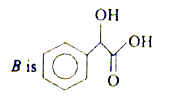An organic compound (A) on treatment with ethyl alcohol gives a carboxylic acid (B) and compound (C). The hydrolysis of (C) under acidic conditions gives (B) and (D). Oxidation of (D) with KMnO4 also gives (B). (B) on heating with Ca(OH)2 gives (E) (molecular formula, C3H6O). (E) does not give Tollens test and does not reduce Fehling's solution but forms a 2,4−dinitrophenyl hydrazone. Identify (A),(B),(C),(D), and (E).
M.F. of E=C3H6O. It does not reduce Fehling solution and does not give Tollens. test but forms 2,4-dinitrophenylhydrazone,
∴ E is a ketone, i.e., CH3COCH3 (propanone)
Propanone is obtained by heating the carboxylic acid B with Ca(OH)2,
∴ B should be acetic acid.
2CH3COOH(B)+Ca(OH)2→Ca(CH3COO)2Calcium acetateHeat−−→CaCO3+CH3COCH3(E)
Since oxidation of (D) with KMnO4 gives acetic acid.
∴ D should be ethanol.
CH3CH2OHEthanol(D)(O)−−−→−H2OCH3CHO(O)−−→CH3COOH(B)
Since hydrolysis of C gives ethanoic acid (acetic acid) and ethanol,
∴ C is ethyl ethanoate (CH3COOC2H5)
CH3COOC2H5(C)H+⇐⇒CH3COOH(B)+C2H5OH(D)
(A) on treatment with ethanol, gives CH3COOH and CH3COOC2H5.
∴(A) is acetic anhydride.
(CH3CO)2O(A)+CH3CH2OH→CH3COOH+CH3COOC2H5
Topper's Solved these Questions
Similar Questions
An organic compound (A) on treatment with ethyl alcohol gives a carboxylic acid (B) and compound (C). The hydrolysis of (C) under acidic conditions gives (B) and (D). Oxidation of (D) with KMnO4 also gives (B). (B) on heating with Ca(OH)2 gives (E) (molecular formula, C3H6O). (E) does not give Tollens test and does not reduce Fehling's solution but forms a 2,4−dinitrophenyl hydrazone. Identify (A),(B),(C),(D), and (E).
View SolutionAn organic compound (A) on treatment with ethyl alcohol gives a carboxylic acid (B) and compound (C). The hydrolysis of (C) under acidic conditions gives (B) and (D). Oxidation of (D) with KMnO4 also gives (B). (B) on heating with Ca(OH)2 gives (E) (molecular formula, C3H6O). (E) does not give Tollens test and does not reduce Fehling's solution but forms a 2,4−dinitrophenyl hydrazone. Identify (A),(B),(C),(D), and (E).
View Solution
Knowledge Check
Compound (A) C8H6O2 on treatment with aq. NaOH followed by acidification gives (B) C3H2O3 which on oxidation gives benzoic acid only:
A B
B C
C D
D
An organic compound (A) on treatment with ethyl alcohol gives a carboxylic acid (B) and compound (C). The hydrolysis of (C) under acidic conditions gives (B) and (D). Oxidation of (D) with KMnO4 also gives (B). (B) on heating with Ca(OH)2 gives (E) (molecular formula, C3H6O). (E) does not give Tollens test and does not reduce Fehling's solution but forms a 2,4−dinitrophenyl hydrazone. Identify (A),(B),(C),(D), and (E).
View SolutionAn organic compound (A) (molecular formula C8H16O2) was hydrolysed with dilute sulphuric acid to give a carboxylic acid (B) and an alcohol (C ). Oxidation of (C ) with chromic acid produced (B). (C ) on dehydration gives but-1-ene. Write equations for the reactions involved.
View SolutionCompound (A) of molecular formula C9H7O2Cl exists in ketoform and predominantly in enolic form (B). On oxidation with KMnO4, (A) gives m-chlorobenzoic acid. Identify (A) and (B).
View SolutionThe compound A on treatment with Na gives B, and with PCl5 gives C. B and C react together to give di Ethyl ether. A,B and C are in the order
View SolutionTwo moles of organic compounds 'A' on treatment with a strong base gives two compounds 'B' and 'C'. Compound 'B' on dehydrogention with Cu gives 'A' while acidification of 'C' yields carboxylic and 'D' with molecular formula of CH2O2. Identify the compound A, B, C, and D.
View SolutionAn organic compound (A) (C6H10O) on reaction with CH3MgBr followed by acid treatment gives compound (B). The compound (B) on ozonolysis gives compound (C ), which in the presence of a base gives 1-acetyl cyclopentene (D). The compound (B) on reaction with HBr gives compound (E ). Write the structures of (A), (B), (C ), (D), and (E ). Show how (D) is formed from (C ).
View SolutionAn organic compound (A) (molecular formula C6H12O2) was hydrolysed with dil . H2SO4 to give carboxylic acid (B) and an alcohol (C). 'C' gives white turbidity immediately when treated with anhydrous ZnCl2 and conc. HCl . The organic compound (A) is
View Solution
